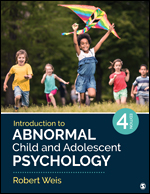Introduction to Abnormal Child and Adolescent Psychology
Robert Weis - Denison University, USA
Also of Interest
Case Studies in Abnormal Child and Adolescent Psychology, also by Weis, presents brief case studies based on real children, adolescents, and families, along with discussion questions that correspond to material in the core text. Bundle Case Studies in Abnormal Child and Adolescent Psychology with Introduction to Abnormal Child and Adolescent Psychology, Fourth Edition for even more savings.
Included with this title:
The password-protected Instructor Resource Site (formally known as SAGE Edge) offers access to all text-specific resources, including a test bank and editable, chapter-specific PowerPoint® slides. Learn more.
Available formats
See what’s new to this edition by selecting the Features tab on this page. Should you need additional information or have questions regarding the HEOA information provided for this title, including what is new to this edition, please email sageheoa@sagepub.com. Please include your name, contact information, and the name of the title for which you would like more information. For information on the HEOA, please go to http://ed.gov/policy/highered/leg/hea08/index.html.
For assistance with your order: Please email us at textsales@sagepub.com or connect with your SAGE representative.
SAGE
2455 Teller Road
Thousand Oaks, CA 91320
www.sagepub.com
Instructor Resource Site
edge.sagepub.com/weis4e
Online resources included with this text
The online resources for your text are available via the password-protected Instructor Resource Site, which offers access to all text-specific resources, including a test bank and editable, chapter-specific PowerPoint® slides.
- A new chapter on child and adolescent research methods covers the essential features of scientific thinking, the dangers of relying on pseudoscience when providing mental health services to children and families, and common methods and research designs used to describe, predict, and explain children’s development.
- A greater emphasis on the ways social-cultural factors affect the presentation, prevalence, course, and treatment of each disorder is seen through chapters that provide expanded coverage of the way children’s gender, ethnicity, language, religion, acculturation, migration experiences, and socioeconomic status might influence the emergence of each disorder and response to treatment.
- Chapters have been updated to reflect the current scientific research and recommended clinical practice, taking into account that the prevalence and demographic distribution of several childhood problems has changed over the last several years.
KEY FEATURES:
- A developmental psychopathology approach to understanding child psychopathology allows readers to study each disorder from multiple levels of analysis (e.g., biological, psychological, social-cultural) with an emphasis on risk and protective factors that shape children’s developmental pathways over time.
- Chapters are split into smaller modules to make material more accessible to students and to allow instructors to easily tailor reading assignments to their courses.
- Modules are organized by research questions such as “How common is autism spectrum disorder?” and “What treatments are effective for toddlers with autism spectrum disorder?” to spark students’ interest and to guide their reading.
- Each chapter provides descriptions of evidence-based treatments identified by professional organizations such as the Society of Clinical Child and Adolescent Psychology and the American Academy of Child and Adolescent Psychiatry.
- Science to Practice sections show how clinicians apply evidence-based treatment in clinics, hospitals, and schools to help children and families in need.
- In-text learning aids include learning objectives, section summaries, key terms with definitions, and critical thinking exercises to help students to master the material.

